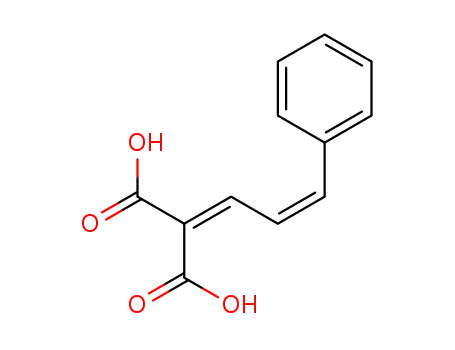Your Location:Home > Products > Food Ingredients > Cinnamaldehyde



CasNo: 104-55-2
MF: C9H8O
Appearance: yellow liquid with an odour of cinnamon
|
Chemical Description |
Cinnamaldehyde and crotonaldehyde are specific examples of a,b-unsaturated aldehydes. |
|
Air & Water Reactions |
Thickens on exposure to air. May be unstable to prolonged exposure to air. Slightly water soluble . |
|
Reactivity Profile |
Cinnamaldehyde reacts with sodium hydroxide owing to aerobic oxidation. |
|
Health Hazard |
Cinnamaldehyde can cause moderate to severeskin irritation. Exposure to 40 mg in48 hours produced a severe irritation effecton human skin. The toxicity of Cinnamaldehydewas low to moderate on test subjects,depending on the species and the toxicroutes. However, when given by oral routein large amounts, its poisoning effect wassevere. Amounts greater than 1500 mg/kghave produced a wide range of toxic effectsin rats, mice, and guinea pigs. The symptomswere respiratory stimulation, somnolence,convulsion, ataxia, coma, hypermotility, anddiarrhea.LD50 value, oral (guinea pigs): 1150 mg/kgCinnamaldehyde is a mutagen. Its carcinogeniceffect is not established. |
|
Fire Hazard |
Cinnamaldehyde is combustible. |
|
Trade name |
ADIOS?; ZIMTALDEHYDE?; ZIMTALDEHYDE? LIGHT |
|
Contact allergens |
This perfumed molecule is used as a fragrance in perfumes, a flavoring agent in soft drinks, ice creams, dentifrices, pastries, chewing-gum, etc. It can induce both contact urticaria and delayed-type reactions. It can be responsible for dermatitis in the perfume industry or in food handlers. Cinnamic aldehyde is contained in “fragrance mix.” As a fragrance allergen, it has to be mentioned by name in cosmetics within the EU. |
|
Anticancer Research |
This is promising in antitumor activity against NSCLC cells. The cells were inducedin apoptosis and also the epithelial-mesenchymal transition was reversed affectingthe Wnt/b-catenin pathway (Bouyahya et al. 2016). |
|
Safety Profile |
Poison by intravenous and parenteral routes. Moderately toxic by ingestion and intraperitoneal routes. A severe human skin irritant. Mutation data reported. Combustible liquid. May ipte after a delay period in contact with NaOH. When heated to decomposition it emits acrid smoke and fumes. See also ALDEHYDES. |
|
Synthesis |
By isolation from natural sources; synthetically, by condensation of benzaldehyde with acetaldehyde in the presence of sodium or calcium hydroxide. |
|
Potential Exposure |
Botanical fungicide and insecticide. Used as an antifungal agent, corn rootworm attractant, and dog and cat repellent. Can be used on soil casing for mushrooms, row crops, turf, and all food commodities. Not listed for use in EU countries. |
|
Shipping |
UN1989 Aldehydes, n.o.s., Hazard Class: 3; Labels: 3-Flammable liquid |
|
Incompatibilities |
Aldehydes are frequently involved in selfcondensation or polymerization reactions. These reactions are exothermic; they are often catalyzed by acid. Aldehydes are readily oxidized to give carboxylic acids. Flammable and/or toxic gases are generated by the combination of aldehydes with azo, diazo compounds, dithiocarbamates, nitrides, and strong reducing agents. Aldehydes can react with air to give first peroxo acids, and ultimately carboxylic acids. These autoxidation reactions are activated by light, catalyzed by salts of transition metals, and are autocatalytic (catalyzed by the products of the reaction). The addition of stabilizers (antioxidants) to shipments of aldehydes retards autoxidation. Incompatible with oxidizers (chlorates, nitrates, peroxides, permanganates, perchlorates, chlorine, bromine, fluorine, etc.); contact may cause fires or explosions. Keep away from alkaline materials, strong bases, strong acids, oxoacids, epoxides, ketones, azo dyes, caustics, boranes, hydrazines |
|
Waste Disposal |
Incineration. In accordance with 40CFR165, follow recommendations for the disposal of pesticides and pesticide containers. |
|
Aroma threshold values |
Detection at 50 to 750 ppb. |
|
Taste threshold values |
Taste characteristics at 0.5 ppm: spicy, cinnamon and cinnamon bark. |
|
General Description |
Yellow oily liquid with a cinnamon odor and sweet taste. |
|
Agricultural Uses |
Fungicide, Insecticide: Used as an antifungal agent, corn rootworm attractant, and dog and cat repellent. Can be used on soil casing for mushrooms, row crops, turf and all food commodities. Not listed for use in EU countries. |
InChI:InChI=1/C9H8O/c10-8-4-7-9-5-2-1-3-6-9/h1-8H/b7-4-
Carbonyl compounds were regenerated from...
An efficient route of organoselenium-cat...
The highly enantioselective (up to >99.5...
endo-Bicyclohepta-5-en-2-ol (1a) on reac...
The efficient and environmentally benign...
The relative rates of catalytic oxidatio...
A facile, efficient oxidative deblocking...
Herein, we report a mild and environment...
Laccase from Trametes versicolor was imm...
The selective oxidation of ethylbenzene ...
The catalytic activity of Co-ZIF-9, a ze...
The new complexes t-py), nicotinic acid...
-
Chagas disease is caused by infection wi...
Surfactant-free tiny Pt clusters were su...
The first example of chiral secondary am...
A copper(II)–nickel(II)-based catalyst s...
Colloidal deposition of gold nanoparticl...
Reduction of allylic alcohols can be pro...
Au-Pd bimetal catalysts supported on lay...
A new reagent, potassium permanganate ad...
-
5-Fluoro-2-azaadamantane N-oxyl (5-F-AZA...
Regeneration of carbonyl compounds from ...
The first peroxidovanadium trimer was pr...
-
Two manganate(VI) reagents have been pre...
Two pentavalent chromium complexes have ...
Barium dichromate is used as a mild oxid...
A manupulatively simple and rapid method...
Manganese oxide (Mn3O4) nanoparticles ha...
1-Benzyl-4-aza-1-azoniabicyclo[2.2.2]oct...
Covalent attachment of Schiff base on ma...
The title selenoxide provides a new oxid...
A new reagent, manganese dioxide support...
A novel copper/4-dimethylaminopyridine c...
A method for the synthesis of pyridine d...
A novel magnetic Fe3O4@P4VP(poly(4-vinyl...
Silsesquioxane dioxovanadate(V) complexe...
-
An efficient and practical palladium-cat...
Two homoleptic copper(II) complexes [Cu(...
A Zr-based metal–organic framework with ...
-
We have employed high-intensity ultrasou...
Synthesis of Zn(II) and Ru(II) complexes...
The Cr=C bonds of aryl- and alkenyl(etho...
A simple and selective method for the ox...
Efficient and selective oxidation of pri...
A 1:2 mixture of the poly (l-lactide)-ba...
An Efficient Pd@Pro-GO heterogeneous cat...
-
Homogeneous liquid-phase oxidation of a ...
The disproportionation of alcohols witho...

3-Phenylpropenol


styrene


1-phenylpropene


3-phenyl-propenal
| Conditions | Yield |
|---|---|
|
With
bis(1,5-cyclooctadiene)nickel (0); triphenylphosphine;
In
tetrahydrofuran;
at 30 ℃;
for 48h;
Product distribution;
|
53% 9% |
bis(1,5-cyclooctadiene)nickel (0)


3-Phenylpropenol


styrene


1-phenylpropene

Ni(C6H5CHCHCHO)(P(C6H5)3)2


water


3-phenyl-propenal
| Conditions | Yield |
|---|---|
|
With
triphenylphosphine;
In
tetrahydrofuran;
under N2 or argon or under vac., soln. of org. compd. (3.8 mol) added to mixt. of Ni(cod)2 and PPh3 (1.0/2.2 mol ratio), stirred at 30°Cfor 2 d; detn. by IR and NMR;
|
30% 53% 9% <1 51% |

quinoline

meta-dinitrobenzene

sodium carbonate

(2E)-3-phenyl-2-propen-1-ol

diethyl 2-[3-phenylprop-2-en-1-ylidene]propanedioate

4-phenyl-2-piperidin-1-yl-but-3-enenitrile

2-((Z)-3-Phenyl-allylidene)-malonic acid

(E,E)-1-(4-pyridyl)-4-(phenyl)buta-1,3-diene